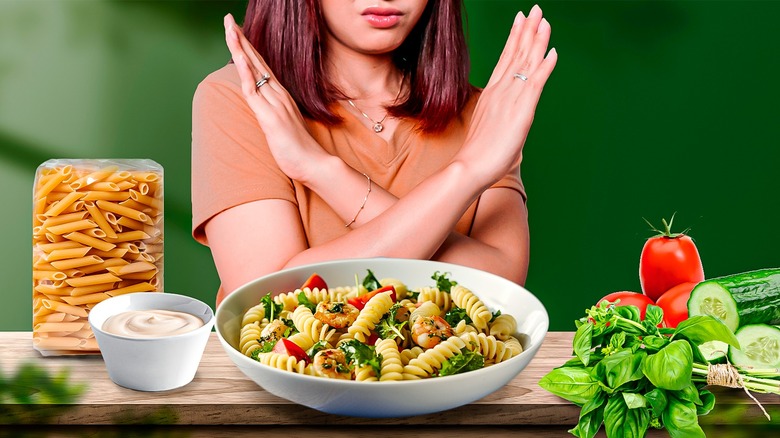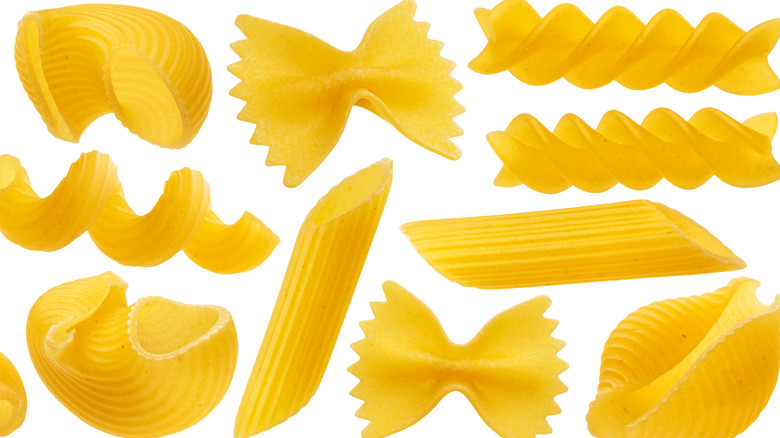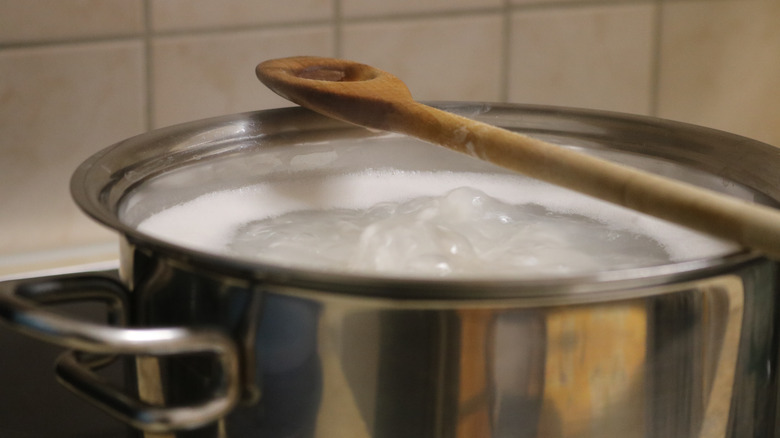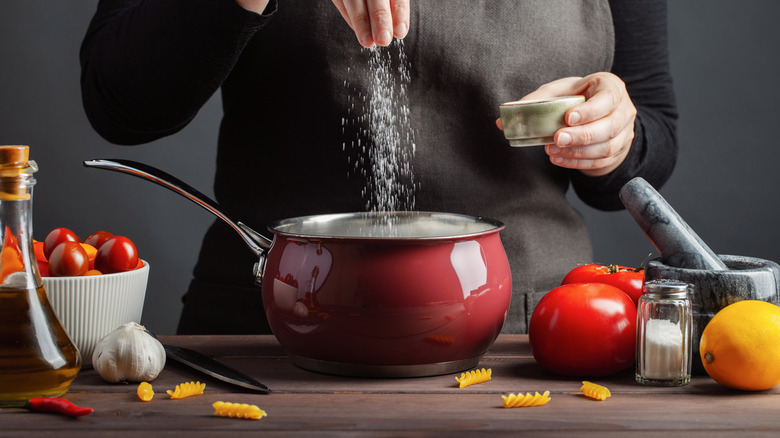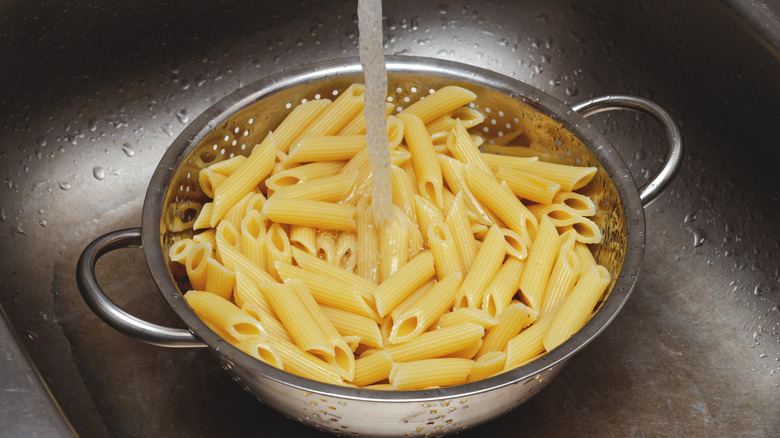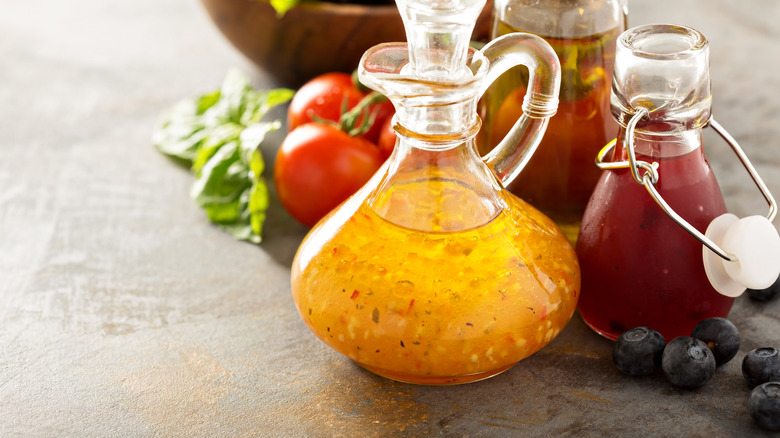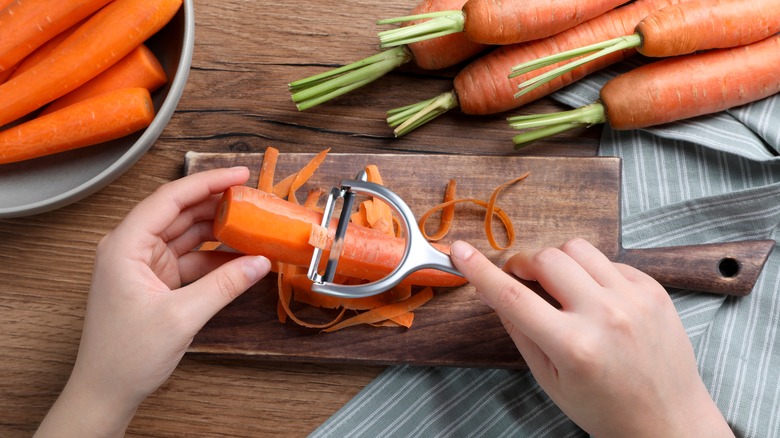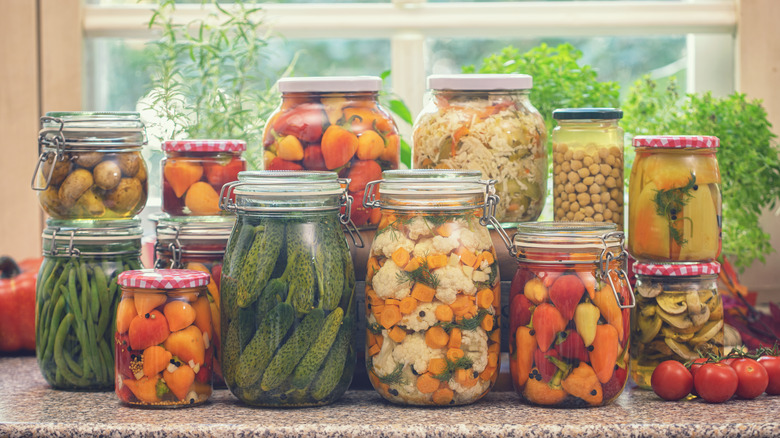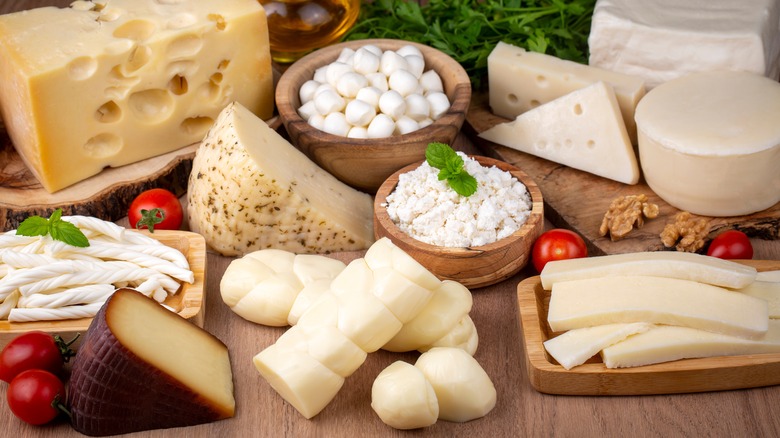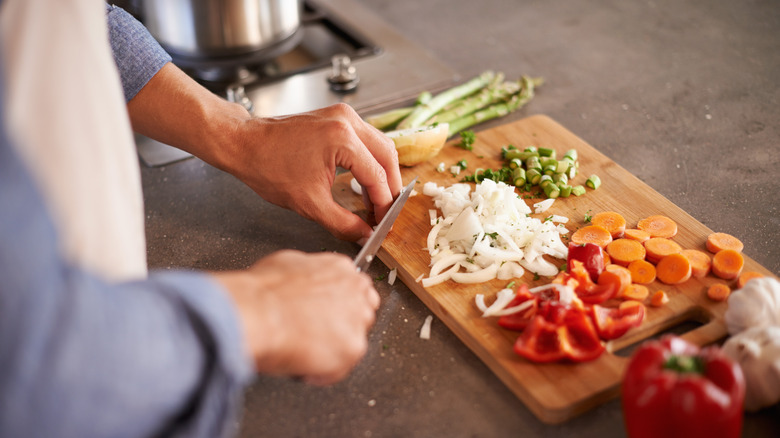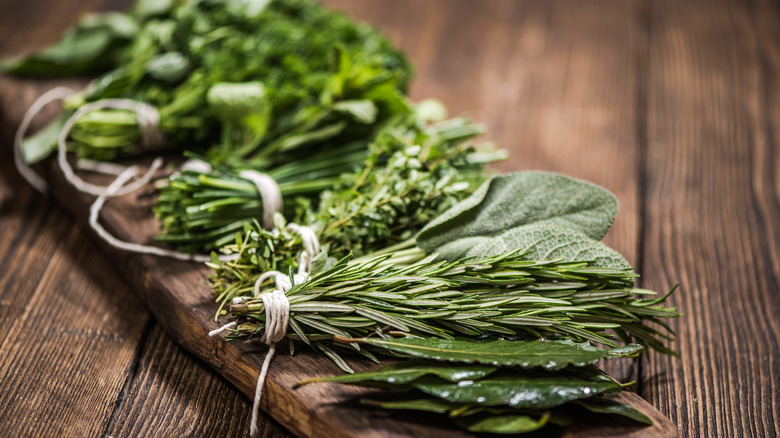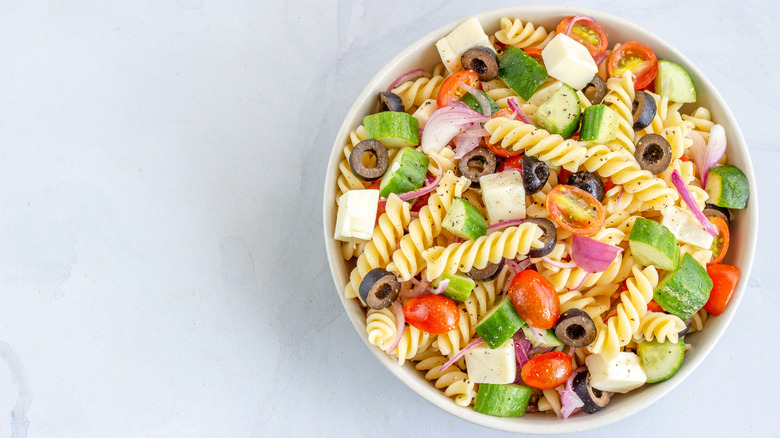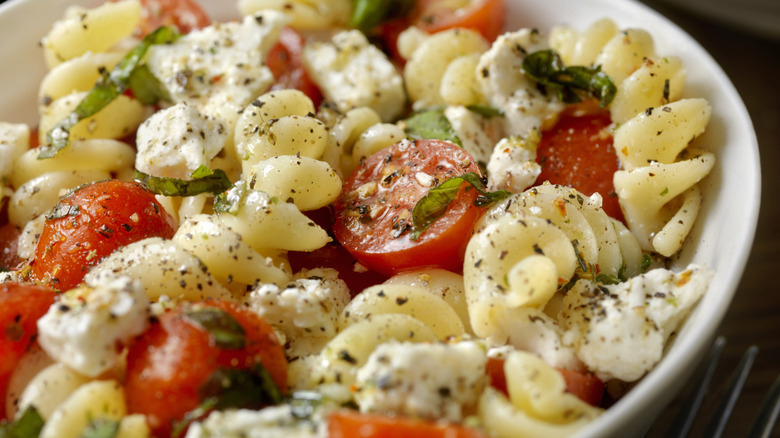12 Mistakes You Are Probably Making With Pasta Salad
When the weather gets warm and the picnic season begins, it's time to bring out your favorite pasta salad recipe. Pasta salad is one of those quintessential warm-weather foods that have a place at every picnic table. And it should because pasta salad is one of the best ways to enjoy the fresh taste of pasta and veggies in a filling salad.
The best thing about pasta salad is there are so many different ways to make it. From classic Mediterranean pasta salad filled with olives and tomatoes to Italian pasta salad with tuna and capers to Spanish pasta salad with smoky chorizo and peppers, just to name a few. While everyone has their own favorite way of making pasta salad, there are a few mistakes that every home chef has made when putting together pasta salad. These common pasta salad mistakes can turn your perfect summer salad into a mushy, flavorless mess.
Luckily, we have a list of some of the common mistakes that everyone makes with pasta salad and how to avoid them so you can make sure everyone's favorite salad turns out delicious every time. Once you perfect your pasta salad game, be ready to make extra because hungry diners will be going back for seconds.
1. Using the wrong pasta shape
Did you know that there are more than 350 different shapes of Italian pasta? There is a good reason why there are so many; different-shaped pasta has various jobs in the pasta world. Long thin pasta, like spaghetti and angel hair, is suitable for light sauces, while wide pappardelle is perfect for a hearty meat sauce. Thicker pasta like fettuccine is good for cream sauce, while small pastina is good for soups. For pasta salads, a smaller irregular-shaped pasta is best.
Many home chefs opt for the screw-shaped pasta called fusilli, and some even insist that fusilli is the best for pasta salad. But fusilli pasta isn't the only shape that works. Basically, the best pasta for pasta salad should be small and have some nooks and crannies to grab onto and hold the dressing. While fusilli fills those requirements, so does cavatappi, the small S-shaped pasta; farfalle, the bowtie pasta; and rotelle, the wagon wheel pasta. Using the right type of pasta is the first step to making an amazing pasta salad. Plus, many of these pasta shapes come in different colors, which is a great way to brighten up your pasta salad and give it a colorful makeover.
2. Overcooking the pasta
One of the biggest challenges to making a good pasta salad is cooking it in the right amount of time. If you undercook the pasta, it will be too hard, and if you overcook, it will be too soft and mushy, especially when it's sitting in dressing. Most seasoned home chefs aim for al dente pasta, which is perfect if you are making a hot pasta dish. But when it comes to pasta salad, where the pasta is served cold, then there are actually some new rules.
When you are making pasta for pasta salad, instead of stopping at al dente, let it cook just a minute or two longer. Because pasta for pasta salad will be served cold, the pasta goes through a process called retrogradation which means the pasta gets too chewy and firm because the starch crystallizes as the pasta cools. At first, it might be challenging to throw the al dente rule out the window, but for cold pasta salad, it's the best way to keep your pasta from ruining the salad with the wrong texture.
3. Not salting the pasta water
One of the fundamental rules in cooking, whether you are making hot or cold pasta, is to salt the water. When you are making pasta, salting the water when it starts to boil is the best way to bring out the flavor of the pasta. As the pasta cooks, it soaks up the salt and infuses it with more flavor.
But the real question is how much salt? Well, people say that the pasta water should be somewhere between the saltiness of tears and the saltiness of the sea. But unless you cry when you cook or live near the sea, those measurements may be difficult to replicate. Luckily, cookbook author Marcella Hazan, author of "Essentials in Classic Italian Cooking," has a more reliable recommendation of where to begin; she advises adding 1½ tablespoons of salt for one pound of pasta, as stated on Food52.
But that measurement doesn't take into account the different types of salt and, of course, personal preference. Many chefs prefer fine sea salt or kosher salt for pasta and then season to taste, but seasoning to taste is based on each chef's personal taste. So home chefs looking for the perfect measurement of salt to pasta might need to play around with the ratio to find the right level of salt that ensures flavorful pasta but isn't overkill for their tastebuds.
4. Cooling the pasta wrong
It might seem like a good idea to rinse cooked pasta in cold water to cool it quickly. But before you reach for the colander and turn on the water, you might want to rethink that approach because rinsing cooked pasta removes the all-important starch from the pasta. And the starch is what helps the flavorful dressing and seasoning cling to the pasta making a taste explosion in every bite. Plus, it leaves the pasta waterlogged, and when you add the dressing to the final product, the whole salad is too wet.
But the pasta whisperers over at Barilla suggest to "spread it out on a cooking sheet, drizzle a single layer of extra-virgin olive oil over it and allow it to cool." The baking sheet lets the pasta cool slowly, and the olive oil keeps it from sticking to the pan. Of course, cooling pasta on a baking sheet takes longer, but in the end, the pasta absorbs more dressing and has more flavor.
5. Adding mayo instead of vinaigrette
There are lots of reasons to leave out the mayonnaise in pasta salad. For starters, it's high in calories at 358 calories per ¼ cup, making mayo-based salads not as healthy as their vinegar-based cousins. Plus, mayonnaise, whether in salads or on its own, needs to be refrigerated. According to My Recipes, if it isn't, and it's left out too long at room temperature or even worse on a picnic table on a hot day, it can quickly start growing bacteria and make diners sick.
For food safety and the safety of your waistline, opt for vinegar-based dressing in pasta salad instead. You can keep it simple with a basic vinaigrette that works with any veggie pasta salad combination. Or you can try other vinaigrettes with different kinds of vinegar, like white wine vinegar, balsamic vinegar, or even champagne vinegar.
Experiment with your pasta salad flavors to find the right one to match your other ingredients. If you always use the basic vinegar-to-oil ratio, which is one part vinegar to three parts oil, you will have a good place to start. Then you can add Dijon, honey, garlic, or fresh herbs to make a delicious and healthy dressing for your pasta salad. When dressing a pasta salad, timing is a factor. You should dress pasta salad when it's warm for the pasta to soak up the dressing while it cools. Then, dress it again before serving.
6. Not peeling the veggies
It's easy to get a little lazy in the kitchen and look for shortcuts which is probably why some home chefs skip the task of peeling their vegetables for pasta salad. But this step is more important than you might think, especially with classic pasta salad vegetables like cucumbers and carrots.
In the case of cucumbers, the peel should be removed before adding it to the pasta salad. Health-conscious home chefs might protest this because the peel is packed with vitamins and minerals. But the peel can also be dirty and potentially covered in germs that can make their way into your body. Plus, cucumber peels have a bitter taste that can ruin a pasta salad. If you clean your cucumbers well you can solve the dirt problem but not the bitter problem. A workaround is you can peel the cucumber in stripes keeping some of the skin but not enough for the taste to be overpowering.
Carrots taste better peeled because they grow in the ground and have tough outer skin. You should peel carrots just like you peel carrots to pickle them, allowing the flavors to penetrate through.
7. Forgetting the pickled veggies
While pasta salad is a great way to get more healthy and colorful vegetables into your diet, many home chefs are focused on fresh vegetables and forget about pickled vegetables. Pickled vegetables add a tanginess and complementary texture to pasta salad. Depending on the style of pasta salad you are making, you could add black or green olives, marinated artichokes or sun-dried tomatoes, pickles, or capers. You can even use some of the brine in your salad dressing to perk up that pasta.
Pickled vegetables are often brined in a vinegar solution and left to soak up the salt and vinegar. But if you opt for lacto-fermented vegetables to add in, you are instantly making your pasta salad healthier. Lacto-fermented foods have a lot of nutritional benefits. And making lacto-fermented vegetables at home is easy, with no special equipment required, just salt, warm water, and patience while they ferment to get that tangy taste. Lacto-fermented green beans, carrots, radishes, and snap peas are excellent choices for pasta salad to give it a little zing.
8. Adding the wrong cheese
Choosing the right cheese for your pasta salad is key to finding the right balance of creamy, bright, and tangy in a pasta salad. When deciding on the right cheese to add, think about texture and fat content. High-fat cheese will become oily and too soft sitting in the dressing. So save the gouda, cheddar, and Swiss for your burger, and don't add them to your pasta salad.
Instead, reach for the crumbly cheeses like Feta and blue cheese. Both can crumble into smaller pieces so they evenly distribute throughout the salad, and you get that cheesy goodness in every bite.
Hard, salty cheeses like Parmesano Reggiano, Pecorino Romano, and Grana Padano work well in pasta salad too. Just make sure to grate them rather than cut them in chunks. If you are making an Italian-inspired pasta salad, mini mozzarella pearls add a creamy texture with a mild flavor that won't overpower the other ingredients. Be sure to choose your cheese wisely to elevate your pasta salad.
9. Adding chunky raw veggies
Another common mistake people make when making pasta salad is to put in fresh crunchy vegetables. While this works great in a crisp green salad, in a pasta salad, the difference in texture between raw vegetables and pasta doesn't work. Before adding in fresh vegetables, you should blanch your veggies. Blanching vegetables is easy, just boil a salted pot of water, and throw in the vegetables when the water is at a full boil.
It's a quick process, and times vary depending on the type of vegetable. For example, broccoli will take around five minutes, while softer vegetables like green beans will only need a minute or two. Use tongs to take them out and place them in an ice bath to stop the cooking. Now you have brightly colored vegetables with their nutrients intact but with a softer bite that complements the texture of pasta.
Don't forget when preparing those vegetables, that size does matter, at least in the case of vegetables in pasta salad. It is important to cut all of the vegetables roughly the same size to keep the texture and the ingredients dispersed evenly throughout the salad.
10. Avoiding fresh herbs
Every home chef knows that herbs and seasoning are key components of a good pasta salad. But many home chefs just reach into the spice cabinet and throw dried herbs into their pasta salad. Unfortunately, this isn't always going to make the pasta salad better. Instead, using fresh herbs is the best choice for pasta salad.
That is because fresh herbs are better in cold dishes. Dried herbs have their place in the kitchen and are best used in cooking hot dishes. When dried herbs are heated, the oils are released, making them more flavorful. But in cold dishes, they won't pack that same flavorful punch. Instead, reach for fresh herbs like basil, oregano, thyme, or sage for a burst of freshness in your pasta salad.
There is a caveat to using fresh herbs, and that is to add them close to when you plan on serving the pasta salad. Because fresh herbs can oxidize or turn brown fairly quickly, so for aesthetic reasons, add fresh herbs before serving so there isn't time for oxidation or browning.
11. Sticking to the same pasta salad recipe
It is easy to find a recipe you like and stick to it, especially if it is a crowd-pleaser. But that is also a mistake because there are so many ways to make pasta salad, and you should try them. From mixing in different vegetables to changing the protein and dressing, you open the doors of creativity and experimentation.
Try mixing in different proteins like smoked salmon, shrimp, or bacon. Cured meats like salami, pepperoni, and pastrami are tasty add-ins. If you want to keep the dish vegetarian, add protein like beans, tofu, or tempeh. Vegetables can be swapped out seasonally to ensure you always have the freshest vegetables. In Spring, add fresh asparagus; in the Summer, heirloom tomatoes; in the Fall, leeks; and in the Winter, add some greens, like Swiss chard or spinach, to make your pasta salad pop.
You can also customize pasta salad with regional flavors. Make a Mexican-inspired pasta salad with corn, black beans, and jalapenos. Or look to India for inspiration and use curry powder and mangoes. When it comes to pasta salad, the possibilities are endless, so make sure to avoid getting into a rut and try some of the thousands of other ways to make this classic dish.
12. Not making it the day before
Salsa, chili, and soups are just some of the foods that taste better the next day, and pasta salad fits in this category too. The combination of cooked pasta, blanched vegetables, cheese, and protein just gets better if you allow it to sit and marinate. The flavors have time to blend, and the whole shebang has a chance to soak up all of the dressing and seasonings. However, there are some considerations to remember when making pasta salad the day before to keep it from being a soggy unappealing mess.
First, it is important not to overly dress your pasta salad. You want the pasta and other ingredients to be coated but not drowning in dressing. After it sits in the refrigerator overnight, remix it, adding in more dressing and another sprinkle of salt to brighten it up. And to avoid allowing it to become too dry, store it in an airtight container in the refrigerator so it won't absorb other odors in the fridge or get stale. Never attempt to freeze pasta, whether in pasta salad, soup, or other dishes; pasta does not freeze well, and it will defrost to a mushy mess.
